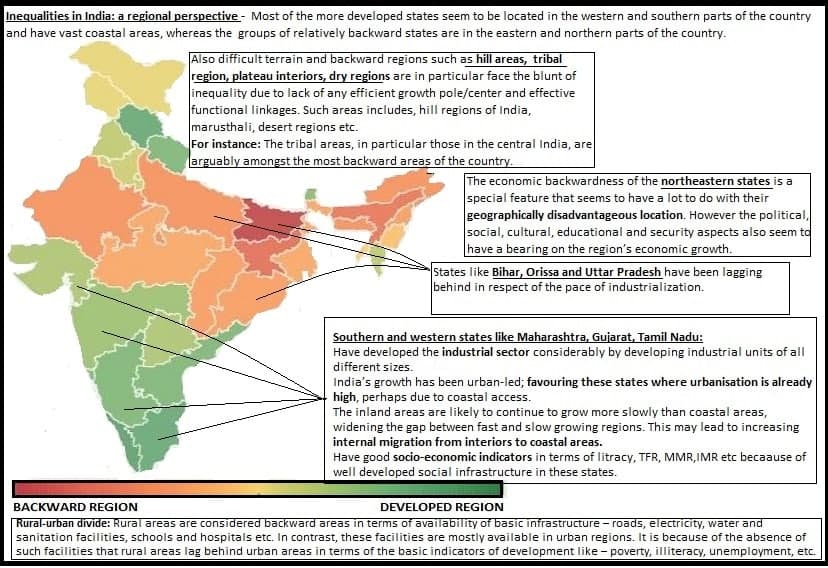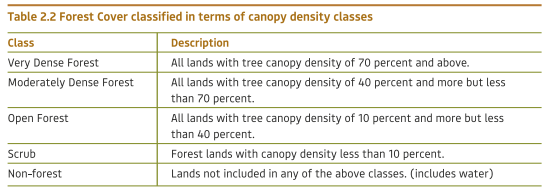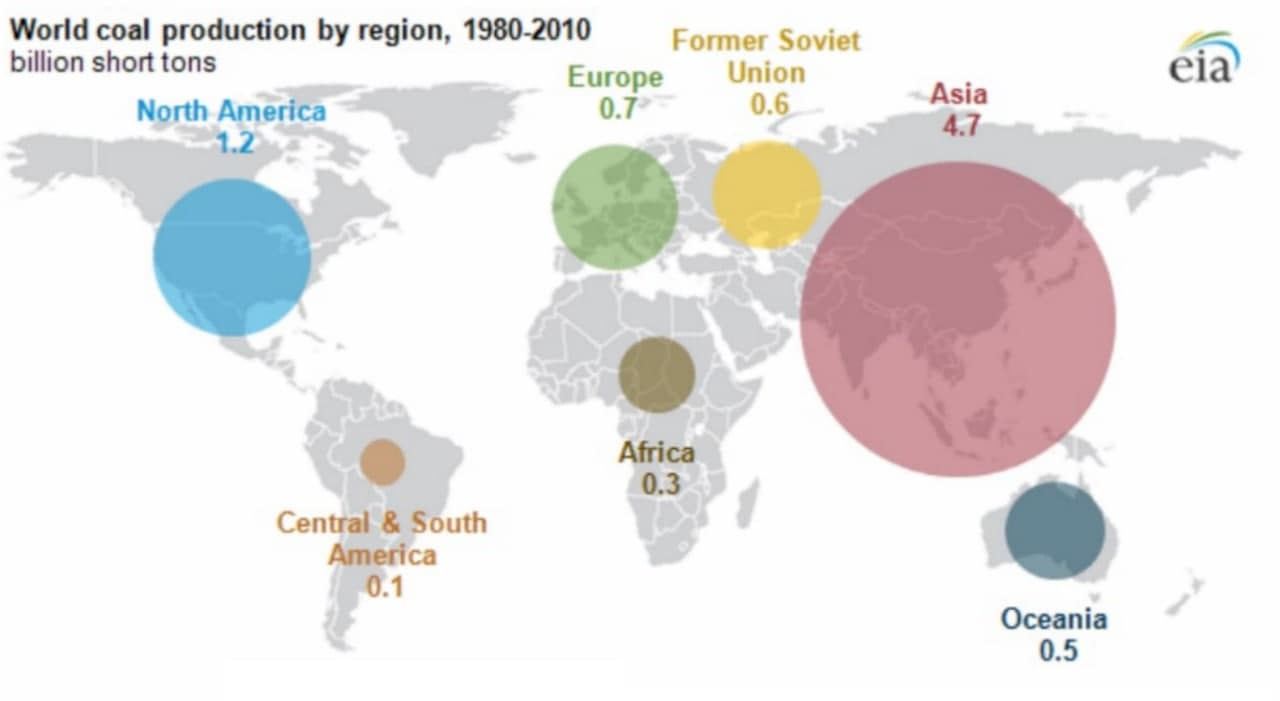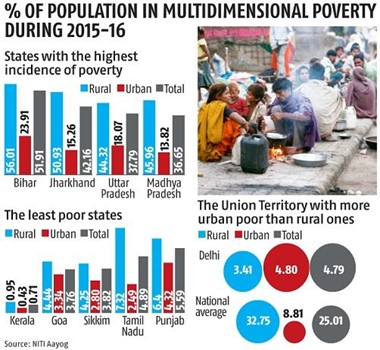05 Feb
Climate smart agriculture- for sustainable agricultural growth in India
In news: Thirty-five such crop varieties with special traits like climate resilience and higher nutrient content have been developed in the year 2021 by ICRA.
Background:
- According to FAO estimates in ‘The State of Food Security and Nutrition in the World, 2020 report, 189.2 million people are undernourished in India. By this measure 14% of the population is undernourished in India.
- The food security challenge will become more difficult, as the world will need to produce about 70% more food by 2050 to feed an estimated 9 billion people.
- The challenge is intensified by agriculture’s extreme vulnerability to climate change.
- The Intergovernmental Panel on Climate Change (IPCC) has highlighted that future agricultural growth will be impacted by climate change. This phenomenon leads to increase in frequency and intensity of extreme events such as drought, heavy rainfall, flooding and high maximum temperatures. Water scarcity and dry regions are likely to increase significantly by the end of the century. Besides, greenhouse gas emissions from agriculture, including due to burning of crop fields and residues, are a principal contributor to climate change.
- This leads to reducing crop yields, the nutritional quality of major cereals, and lowering livestock productivity.
- The change in agricultural productivity patterns as a result of climate change could reduce annual agricultural incomes in the country by between 15 percent and 18 percent on average, and between 20 percent and 25 percent for unirrigated areas.
- Substantial adaptation will be required to maintain current yields and to achieve production and food quality to meet increasing food demand.
- To alleviate some of the complex challenges posed by climate change, agriculture has to become “climate smart”, that is, sustainably increase agricultural productivity and incomes, adapt and build resilience to climate change, and reduce and/or remove greenhouse gas emissions, where possible.
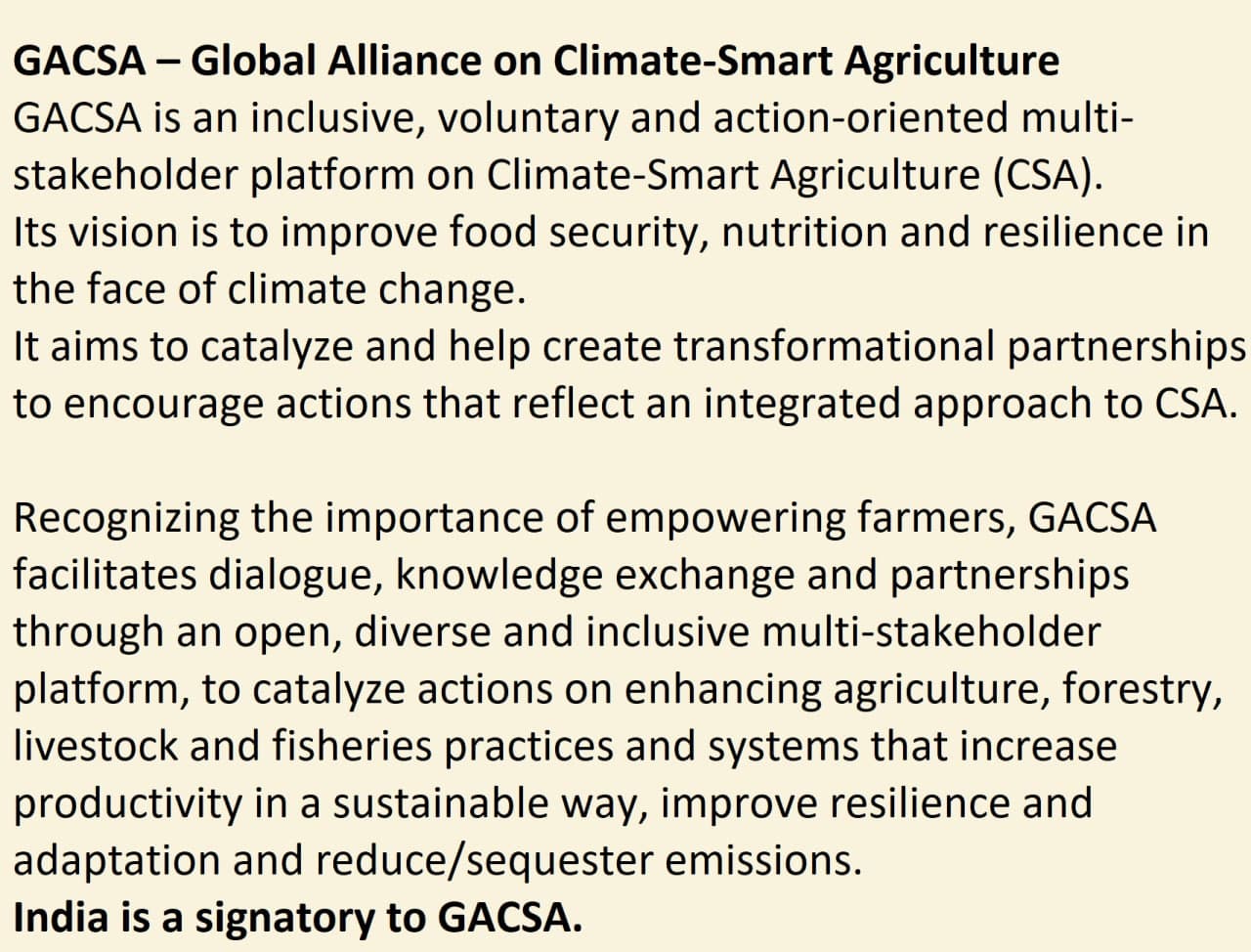
Regional climate related challenges to Indian Agriculture:

What does climate smart agriculture do:
- The Food and Agricultural Organisation (FAO) defines Climate-Smart Agriculture (CSA) as an approach that helps guide actions needed to transform and reorient agricultural systems to effectively support development and ensure food security in a changing climate. It takes into consideration the diversity of social, economic and environmental contexts, including agro-ecological zones.
- CSA can include innovations such as agro-advisory services and weather insurance; solar water pumps, community-based and on-farm water management; adaptive varieties of crops, breeds and seed banks; sustainable livestock management, integrated nutrient management, using biogas and minimum tillage, etc.
- Climate-smart agriculture (CSA) is an integrated approach to managing landscapes—cropland, livestock, forests and fisheries--that address the interlinked challenges of food security and climate change. CSA aims to simultaneously achieve three outcomes:
- Increased productivity: Produce more and better food to improve nutrition security and boost incomes, especially of 75 percent of the country’s poor live in rural areas and mainly rely on agriculture for their livelihoods.
- Enhanced resilience: Reduce vulnerability to drought, pests, diseases and other climate-related risks and shocks; and improve capacity to adapt and grow in the face of longer-term stresses like shortened seasons and erratic weather patterns.
- Reduced emissions: Pursue lower emissions for each calorie or kilo of food produced, avoid deforestation from agriculture and identify ways to absorb carbon out of the atmosphere.
How climate smart agriculture sustain agriculture production in India: Climate-Smart Agriculture (CSA) takes into consideration the diversity of social, economic and environmental contexts, including agro-ecological zones.
CSA contributes to the development of climate-resilient agricultural systems by increasing soil characteristics and the efficiency of water and nutrient use and by providing more stable yields and reducing emissions of GHGs. It takes into consideration following interventions:

Crop Production Management: Sustainable crop production intensification (SCPI) is a method of Agriculture crop production (ACP) that conserves and enhances natural resources and reduces the harmful impacts on the environment by using natural biological inputs and processes. It contributes to making agricultural systems resilient concerning CC through following strategies:
- Conservation agriculture (CA), implies less soil disturbance, residue retention, and crop rotation, involve no or minimal tillage with direct seeding and planting of crops, residue management, and crop diversification. It has the potential to improve productivity and soil quality, Conservation farming systems seem to be a viable option for achieving safe and intensive ACP in various agro-ecological environments because they allow effective use of available resources and preserve soil fertility.
- Integrated nutrient management, which supplies nutrients to the crops from all possible sources like inorganic fertilizers, green manure, biofertilizers, and organic manure, can drastically reduce the demand for chemical fertilizers, thereby reducing GHG emission.
- Mulch cropping and cover cropping are very useful in maintaining soil health and favorable soil conditions for crop growth. These practices also protect the soil from erosion.
- Diversification of crops can build resilience in several ways, such as creating the capacity to control pest outbreaks, dampening pathogen spread, protecting ACP from the harmful effects of increased CV as well as EWE, and rising household income.
- Precision agriculture, which involves the application of inputs at the appropriate time, by the appropriate method, and at the appropriate location through the use of RS and GIS, sensors, and variable rate applicators, should be adopted for increasing productivity, increasing input use efficiency, and protecting the environment.
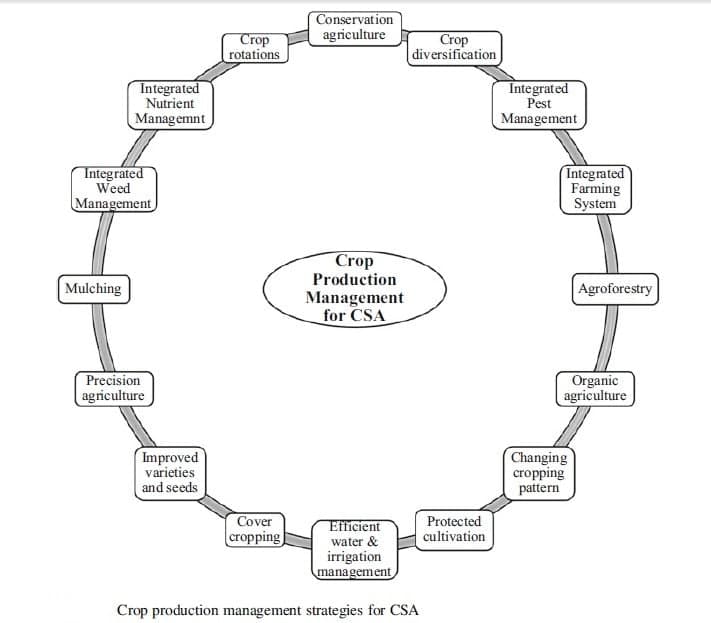
Water management:
The impacts of climate change on agricultural water are estimated to be through the increased rainfall variability, higher temperatures, and life-threatening EWE like floods and droughts. In this scenario, sustainable water management is essential under CC mitigation. In the water management practices, more attention is given to irrigation scheduling, micro irrigation, precision irrigation, efficient drainage systems, in situ moisture conservation, and rainwater harvesting structures to contribute toward CSA.
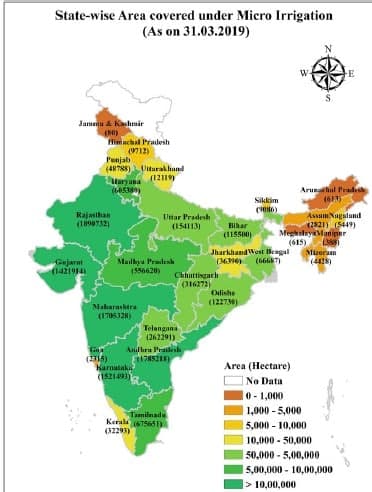
Livestock diversification:
Livestock diversification is an approach in CSA for increasing resistance against CC-related pests and diseases. The breeds having a higher tolerance to temperature and humidity, resistance toward diseases, and the ability to survive under low input conditions should be reared.
Managemental strategies can help in building CC adaptation in livestock are:
- A regular supply of clean and cool water to animals.
- Splashing cool water on animals during a hot period at regular intervals can reduce heat stress.
- Animals should be kept under proper shade as well-designed shades can reduce the heat load of about 30–40% on animals.
- Ventilation and air circulation should be increased in animal sheds by the use of fans and open housing system.
- Plantation of trees around cattle sheds can provide long-term cooling effect.
Genetic Approaches for Building Climate Resilience: in climate smart agriculture, transfer of stress-tolerant or resistance genes through genetic engineering or molecular plant breeding to the target crop can make the crops adaptable to CC.
For CC adaptation, the following traits are mainly required in the crops:
- Tolerance to water and temperature stress
- Tolerance or resistance to pests and diseases
- Ability to efficiently utilize scarce nutrient supply
- Capacity to grow under poor soil conditions
- Phenotypic plasticity
Developing new crop varieties having higher yield potential as well as resistance or tolerance to multiple stresses such as drought, salinity, flood, etc. is essential for maintaining yield stability. Under the CC scenarios, it is crucial to develop varieties with tolerance toward multiple abiotic stresses and a variety of responsive inputs.
Case study: “Climate-Resilient Agricultural Practices - Climate-Smart Villages”- Haryana
- Agricultural challenges: Crop season shifting, temperature alterations, increased requirement of water for irrigation, over-exploitation of groundwater resources, declining organic matter in soil, multiple plant nutrient deficiencies, etc have been affecting productivity in the districts. There is also evidence of large yield gaps, especially ‘management yield gaps’ (crop loss due to poor management in farmers’ fields) in crops such as wheat, paddy and maize.
- Project undertaken to promote climate resilient agricultural practices: state is taking great strides toward sustainability by scaling up implementation of the “Climate-Resilient Agricultural Practices - Climate-Smart Villages” Project.
- It seeks to make 75,000 farming families in 250 villages of 10 paddy/wheat-growing districts more resilient against climate change.
- The scaled-up project proposes adoption of sustainable agricultural practices in model fields on community lands. These include zero tillage, raised bed planting, direct seeded rice, crop residue management and cropping diversification (horticulture, bee keeping, mushroom cultivation, etc). Besides, site-specific nutrient management, laser levelling, micro-irrigation, seed/fodder banks, ICT-based weather advisories and knowledge sharing are also implemented.
- Interventions in managing water, weather, nutrients and carbon energy were successfully adopted.
he Government of India is implementing the National Mission of Sustainable Agriculture (NMSA), one of the 8 missions under the National Action Plan on Climate Change (NAPCC). Parallelly, the Pradhan Mantri Krishi Sinchayee Yojana (PMKSY) envisages “Per Drop More Crop” for promoting micro/drip irrigation to conserve water. There is also a push for cluster-based organic farming through the Paramparagat Krishi Vikas Yojana (PKVY). The mission of these programmes is to extensively leverage adaptation of climate-smart practices and technologies in conjunction with the Indian Council of Agricultural Research (ICAR) and state governments.
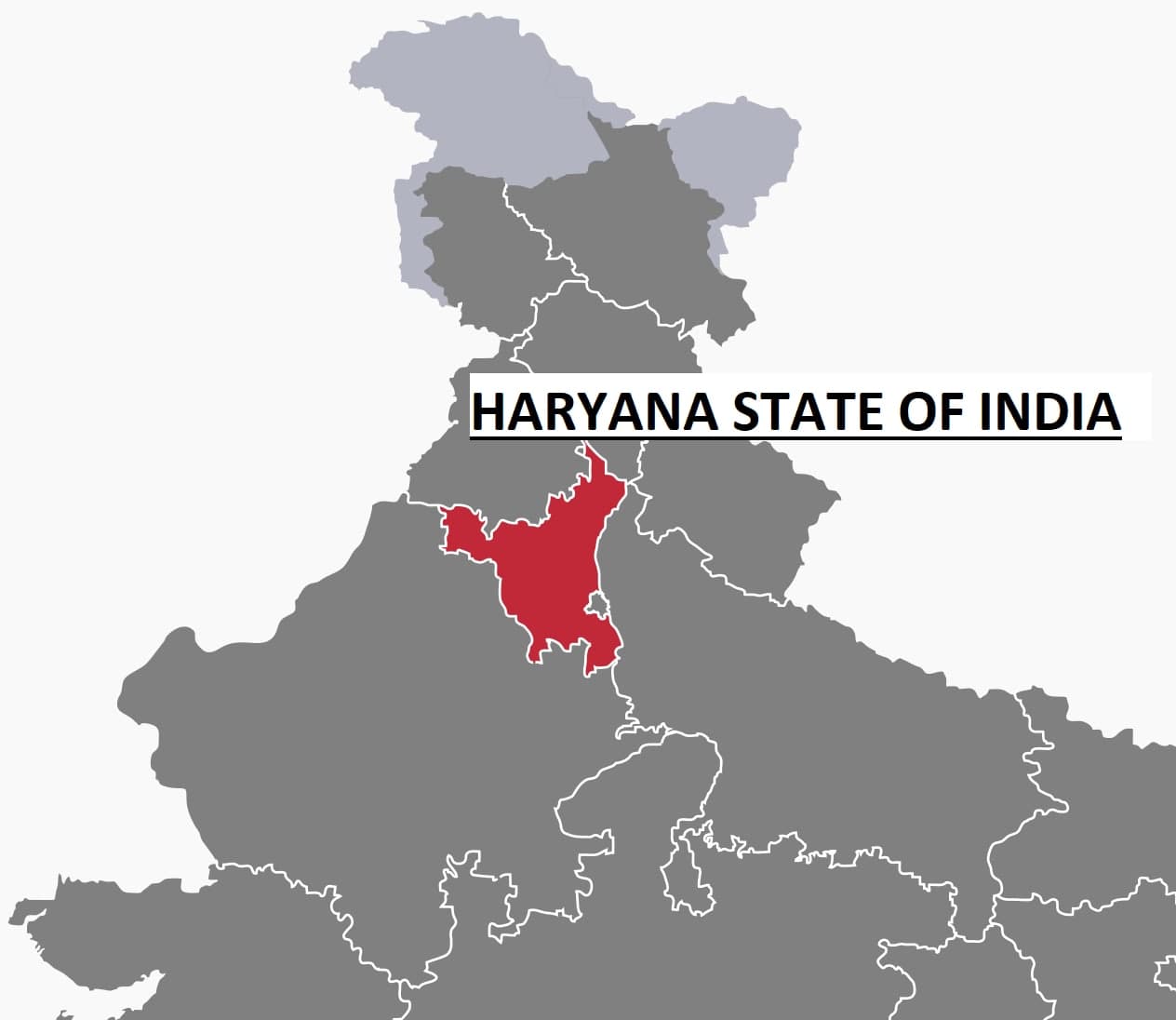
Need for sustainable fly ash management in India
Why in news: The National Green Tribunal (NGT) directed the constitution of a ‘Fly Ash Management and Utilisation Mission’ in its order dated January 18, 2022.


Why there is a need for sustainable fly ash management in India?
- Environmental concerns:
- Air Pollution: Fly ash contains toxic and heavy metals. The ponds where fly ash is usually dumped are poorly managed. Fly ash becomes dry as temperature increases and gets Thus, it becomes one of the major sources of air pollution. Fly ash is a major source of PM 2.5, fine, pollution particles, in summer it causes air pollution.
- Water contamination: The wet disposal of Fly ash results in leaching of toxic heavy metals into ground water Also, Fly ash can contaminate surface water through erosion, surface runoff, and airborne particles landing on the water surface, contaminated ground water moving into surface waters, flooding drainage, or discharge from a coal ash pond.

-
- Soil contamination: Fly ash dust can be deposited on topsoil increasing the pH and affecting the plants and animals in the surrounding ecosystem. Soils contaminated by fly ash showed an increase in bulk density and water capacity, but a decrease in hydraulic conductivity and cohesiveness. These contaminated soils are detrimental to plant growth and development.
- Health concerns: Inhalation or ingestion of the toxins in fly ash can have impacts on the nervous system, causing cognitive defects, developmental delays, and behavioral problems while also increasing a person's chance of developing lung disease, kidney disease, and gastrointestinal illness.
- Over dependence on coal for energy: Indian coal is of low grade with ash content of the order of 30-45 % in comparison to imported coals which have a low ash content of the order of 2-15 %. However, coal accounts for 70% of India's power generation. Thus, it becomes imperative to sustainably manage the fly ash generated from the coal power plants so as to tackle to the twin challenges of environmental pollution and climate change.
- Lopsided utilization: Though there are some power plants which have achieved Fly Ash Utilisation Level of more than 100 %, half of India’s coal-fired thermal power plants failing to meet the December 2017 target of 100 per cent ash utilisation mandated by the government. Many plants fail to utilize even 30–40% of the fly ash they generate.
Initiatives taken by the government of India for sustainable management of Fly ash:

Way forward:
- Clean Coal Technologies (CCTs): Coal cleaning by “washing” has been standard practice to reduce emissions of ash and sulfur dioxide. Electrostatic precipitators (ESPs) and fabric filters (FFs) can remove more than 99.9% of the fly ash from the flue gases.
- Fly ash in construction industry- A clean approach to environment management: India is an agriculture-based country. The overuse of soil for the production of construction materials like blocks, tiles, roof materials, etc. results in nutrient depletion, erosion, and other forms of degradation, hence the soil productivity declines; it also reduces the area available for agricultural use. By utilizing fly ash as a fill material, an equal volume of top soil, which will otherwise be used in filling, can be saved.
Where it can be used?
It can be used in topics related to Paper 1 (Soil degradation, Environmental degradation, and World industries), Paper 2 (Ground water, Chemical industries, Environmental utilization, health indicators) and GS 3 (Environmental degradation).
Sources:
- 1) Fly ash generation and utilization in India during 2020-21
- 2) Fly Ash Management and Utilisation Mission: Will it boost handling, disposal of by-product
- 3) Fly ash – waste management and overview : A Review
- 4) Fly ash as a Resource Material in Construction Industry: A Clean Approach to Environment Management
Challenges of jute industry in India
Why in news: Battered by raw material shortage and supply chain disruptions due to the ongoing COVID-19 pandemic, the more than 150-year-old jute industry failed to meet demand for food grain packaging in 2021.

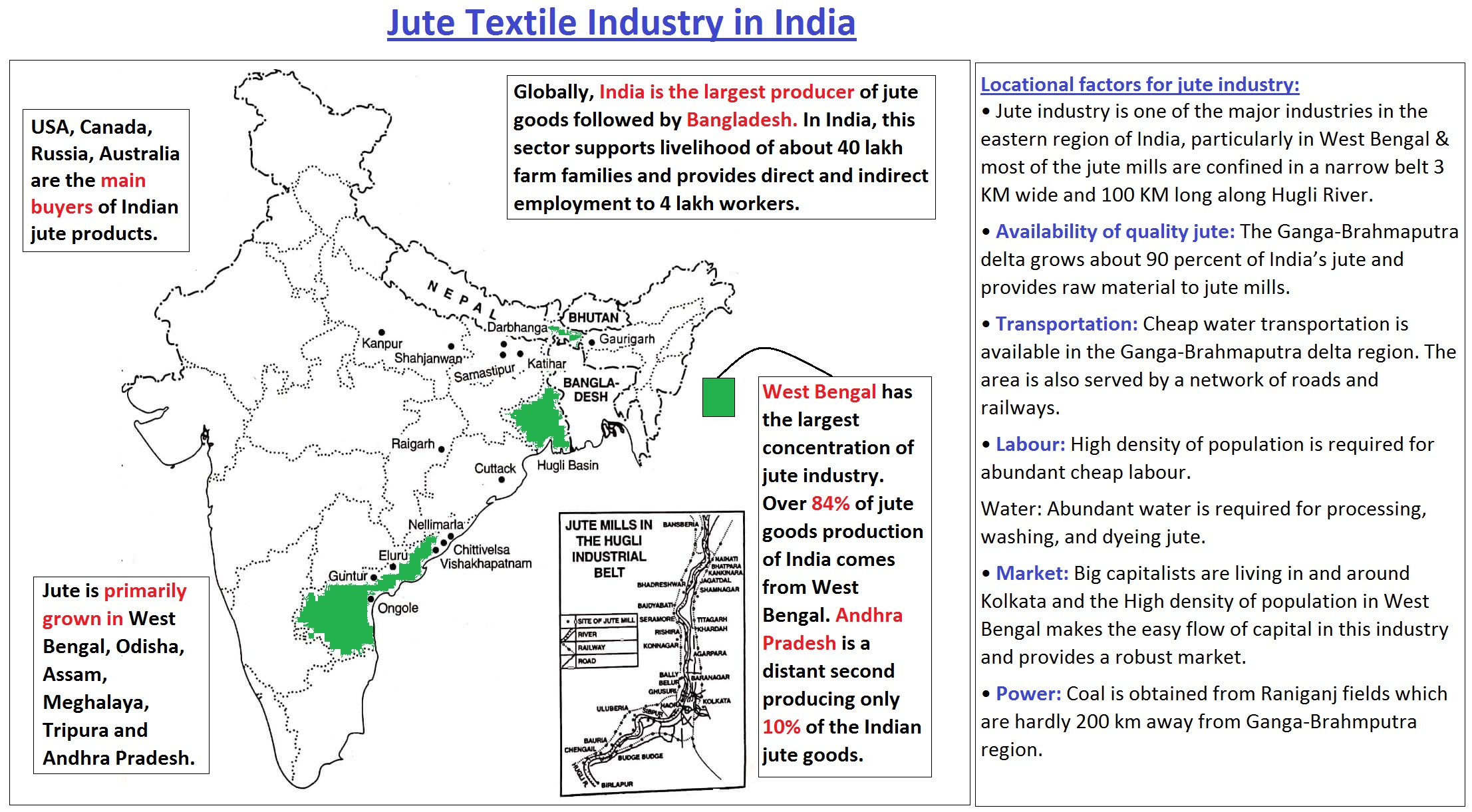
Challenges faced by the jute industry in India:
- Lack of modernization: The current machinery used in most of the mills in India is obsolete technology leading to reduced productivity and product quality. This has impacted the overall competitiveness of the industry in the export market. According to a report by Standing Committee, of the study conducted in 66 jute mills in India, it was found that the capacity utilization in most of these mills is between 50 to 83 per cent only.
- Shortage of raw material: Most of the jute-producing areas went to Bangladesh (erstwhile East Pakistan) during partition resulting in an acute shortage of raw jute. Although successful efforts have been made to increase the supply of raw jute since Independence, it still falls short of our current requirements.
- Stiff competition: The newly established mills and improved machines in Bangladesh are able to produce better quality of goods at cheaper rates and have an edge over the Indian jute products in the international markets. Thus, Indian jute industry are lacking behind in export market in front of Bangladesh jute industry.
- Low yield per Acre: India produces very low quantity of jute per unit of land. In fact, among the producing countries, Indian production is, perhaps, one of the lowest. In Bangladesh the average yield per hectare is 1.62 tonnes. It is only 1.3 tonnes per hectare in India. The corresponding figure of jute production in China is 1.78 tonnes per hectare. Low yield results in less profit for farmer and thus minimizes the reinvestment from farmer. These figures indicate that there is ample scope to increase Indian productivity.
- Warehousing and storage of raw jute: It is one of the major problems of Indian jute sector. Due to lack of storage facility it leads to uneven supply of raw material, which causes erratic price fluctuations and this discourages jute farmers. Due to this, Indian jute products manufacturers are not able to compete in world market as well as they are not able to fulfil the domestic demand.
- Substitute materials: Jute production is very much localized in the Indian sub-continent. Heavy dependence on erratic Indian jute supply forced the other countries to evolve substitutes such as synthetic fibers. This led to decrease in demand for jute products. For example, hemp and plastics bags have hit the jute industry in India hard.
- Lack of product diversification: With the Jute Packaging Materials Act of 1987, the jute industry has been safeguarded leading to lack of incentive to innovate and improve processes as well as to diversify and reduce costs. Lack of diversification acts as a barrier to the industry moving up the value chain and also increase export of jute products of countries like Bangladesh.
- Lack of incentive mechanism for improving the Jute quality: The focus of Indian Council of Agricultural Research has been on improving the yield of the jute seeds leading to the fiber quality being compromised.
- Current pricing mechanism doesn’t consider quality. The sale of produce at farmers’ level is un-assorted and un-graded. Thus, farmers have no incentive to improve grading and quality of jute.
- Insufficient water resources result in poor retting which in turn impacts quality and grading of jute fibre.
- Poor agricultural practices: While different technologies and dosages of fertilizers have been developed by CRIJAF (Central Research Institute for Jute & Allied Fibres), a few farmers have adopted the technologies and prescribed norms. Due to this low adoption of new technologies, there is currently a wide gap between the potential yield of 2.7 tons/hectare and actual yield of 2.1 tons/ hectare.
Initiatives taken by the government to revamp the jute industry in India:

Way forward:
- Jute for sustainable development: Some of the advanced countries are becoming conscious about the environmental degradation with the increasing use of non-biodegradable materials such as plastic bags for packaging and are trying to discourage such a practice. This has once again turned the tide in favour of jute bags due to their eco-friendly and renewable nature.
- Porter’s model for jute industry: The policy seeks to strengthen R&D activities in agricultural practices with public-private partnership with a vision to ensure remunerative prices to millions of jute farmers by enabling them to produce better quality jute fibre for value added diversified jute products and enhance per hectare yield of raw jute.
Where it can be used?
This can be used in topics related to Paper 1 (World industries, Regional development strategies), Paper 2 (Locational factors of jute textile industry, Agro-based industries, RDP) and GS 3 (Industrial growth, Agriculture).
Sources:
Cryokarst
Cryokarst or Thermokarst is an erosional process unique to permafrost with excess ice; it is defined as ‘the process by which characteristic landforms result from the thawing of ice-rich permafrost and/or melting of massive ice.
The land surface type occurs in Arctic areas, and on a smaller scale in mountainous areas such as the Himalayas and the Swiss Alps.
Features:
- Cryokarst is characterized by small depressions or pits that develop due to settlement of overlying deposits into voids formed by the melting of entrapped ice.
- These pitted surfaces resemble clusters of small lakes formed by dissolution of limestone in some karst areas, which is how they came to have "karst" attached to their name, even though no limestone is actually present.
- The Batagaika crater in Siberia is an example of a large Thermokarst depression.
- Glacial karst processes give rise to draining systems of a melting glacier.

Fig 1: Thawing permafrost in Herschel Island, Canada

Sources:
PM kusum Yojana
PM-KUSUM (Pradhan Mantri Kisan Urja Suraksha evam Utthaan Mahabhiyan) Scheme is aimed at ensuring energy security for farmers in India, along with honoring India’s commitment to increase the share of installed capacity of electric power from non-fossil-fuel sources to 40% by 2030 as part of Intended Nationally Determined Contributions (INDCs). The Scheme is for farmers for installation of solar pumps and grid connected solar and other renewable power plants in the country.
It aims to add solar and other renewable capacity of 25,750 MW by 2022 .
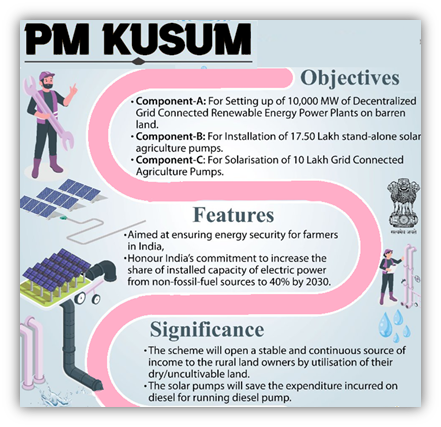
Scheme benefits:
- It promises a stable and continuous source of income to the rural land owners for a period of 25 years by utilisation of their dry/uncultivable land.
- The scheme will promote decentralized solar power production, and reduce transmission losses.
- It ensure that sufficient local solar/ other renewable energy based power is available for feeding rural load centres and agriculture pump-set loads, which require power mostly during the day time.
Challenges
- Awareness challenge: Barriers to adoption include limited awareness about solar pumps.
- Upfront contribution: The other barrier includes farmers’ inability to pay their upfront contribution.
- Limited progress on two models: Progress on the other two models has been rather poor due to regulatory, financial, operational and technical challenges.
Sources:
Soil Health Management
Soil Health Management (SHM) is one of the most important interventions under NMSA. It aims at promoting Integrated Nutrient Management (INM) through judicious use of chemical fertilisers including secondary and micro nutrients in conjunction with organic manures and bio-fertilisers for improving soil health and its productivity; strengthening of soil and fertiliser testing facilities to provide soil test based recommendations to farmers for improving soil fertility; ensuring quality control requirements of fertilisers, bio-fertilisers and organic fertilisers; upgradation of skill and knowledge of soil testing laboratory staff, extension staff and farmers through training and demonstrations; promoting organic farming practices etc.
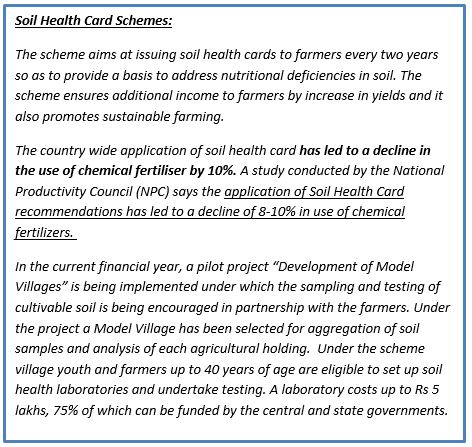
Objectives:
- Regulated nutrient supply for optimum crop growth and higher productivity.
- Improvement and maintenance of soil fertility.
- Zero adverse impact on agro – ecosystem quality by balanced fertilization of organic manures, inorganic fertilizers and bio- inoculant.
Benefits:
- Enhances the availability of applied as well as native soil nutrients.
- Synchronizes the nutrient demand of the crop with nutrient supply from native and applied sources.
- Provides balanced nutrition to crops and minimizes the antagonistic effects resulting from hidden deficiencies and nutrient imbalance.
- Improves and sustains the physical, chemical and biological functioning of soil.
- Minimizes the deterioration of soil, water and ecosystem by promoting carbon sequestration, reducing nutrient losses to ground and surface water bodies and to atmosphere.
Sources:
Rain water harvesting (RWH) systems and sustainable development in industrial land use
- Project:
- RWH systems at textile factories manufacturing readymade garments (RMG) in Narayanganj district, Bangladesh.
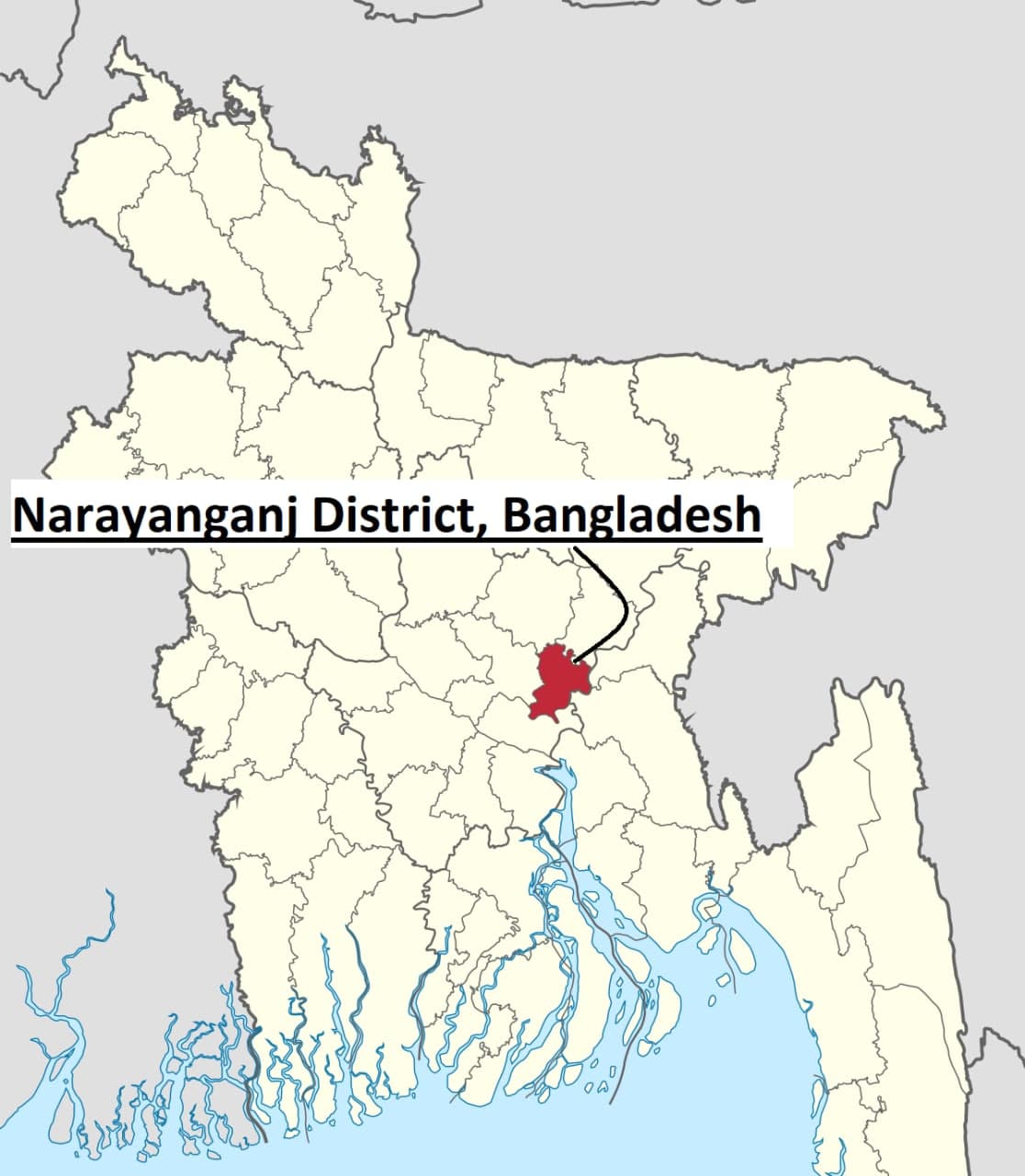
- Challenges:
- Bangladesh faces challenges such as flooding and inundation as well as water shortages and droughts.
- Water is used for production purposes: Industrial water demand is expected to increase by 109 per cent in Bangladesh, where textiles dominate the industrial sector: Bangladesh’s textile industry consumes around 1,500 billion litres of groundwater annually for washing and dyeing of fabrics.
- Also, offices and factories necessitate supply of water to meet the sanitation and drinking demands of their huge workforce.
- Most of the RMG and textile factories in Bangladesh are situated in the central part of the country, closed to the capital Dhaka, that is susceptible to a high depletion rate of groundwater (level decreases by 1-2 meters due to more withdrawal than recharge).
- Steps taken:
- RWH and decentralised wastewater treatment in the urban water management sector- industrial sector.
- RWH systems for production purposes in industries: team calculated rainfall intensity, run-off coefficient of roof material and catchment area to estimate how much rainwater could be harvested.
- The RWH system at RMG factories treats For this, rainwater is being stored and passes through a stone bed filter to meet industrial demands.
Outcome:

Ramanathapuram
|
Ramanathapuram
|
|
Srikakulam
|
|
Pong Dam
|
|
Chilika Lake
|
|
Bannerghatta National Park (BNP)
|
|
Mount Abu
|
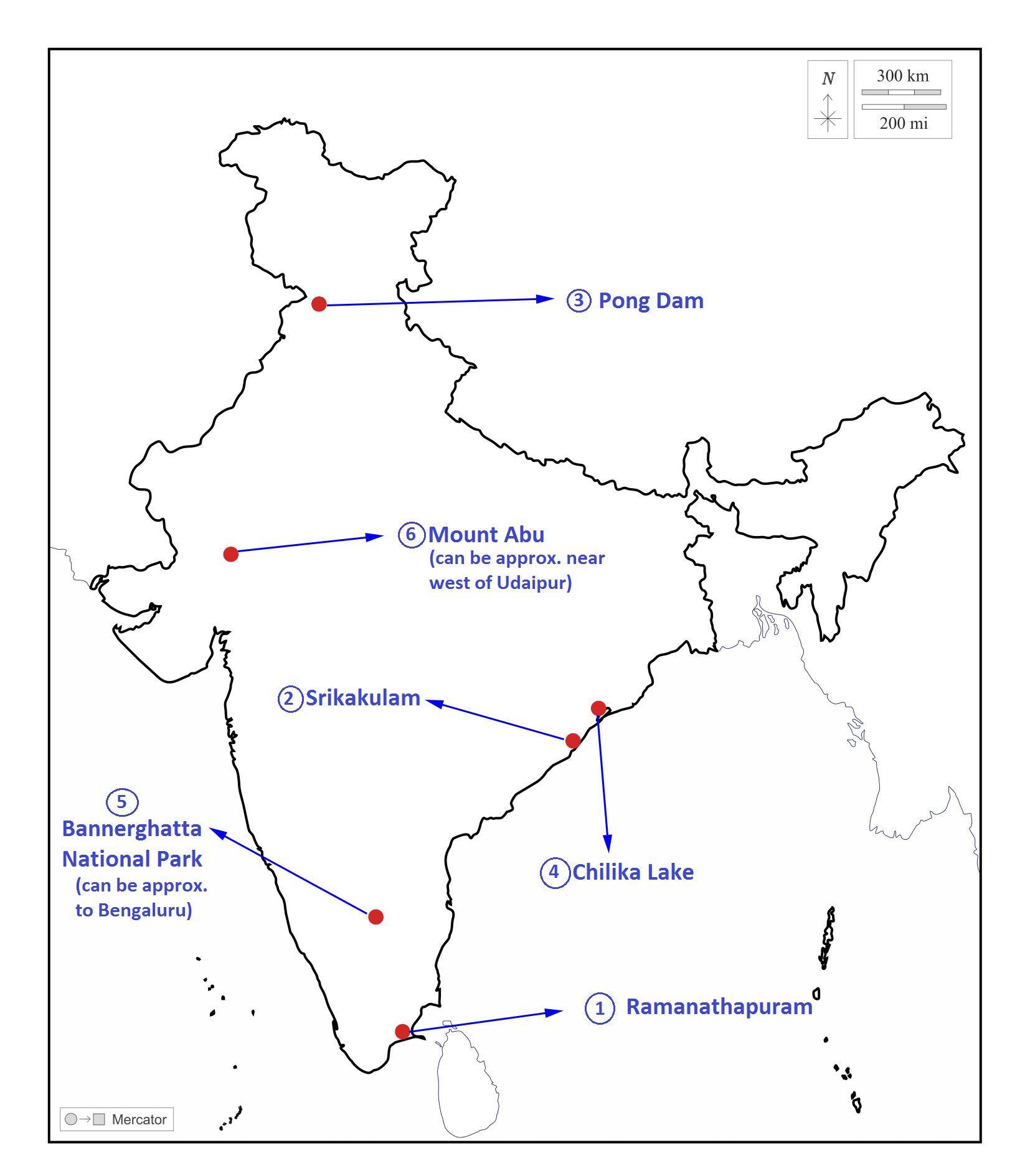
Share the article
Get Latest Updates on Offers, Event dates, and free Mentorship sessions.

Get in touch with our Expert Academic Counsellors 👋
FAQs
Geography Current Affairs focuses on the contemporary issues, events, and developments in the field of geography. It covers recent geographical phenomena, environmental changes, geopolitical shifts, and related news. This differs from regular geography studies which may focus more on foundational concepts, historical contexts, and theoretical frameworks.
Updates are provided regularly to ensure that subscribers stay informed about the latest developments in geography. Typically, updates are provided on a fortnightly basis, depending on the frequency of significant events and changes in the field.
Absolutely. Geography Current Affairs serves as a valuable resource not only for Geography optional but also for GS papers, especially GS Paper 1 (covering Indian Heritage and Culture, History, and Geography of the World and Society) and GS Paper 3 (covering Technology, Economic Development, Biodiversity, Environment, Security, and Disaster Management). It aids in building a holistic understanding of various topics and strengthens answer-writing skills by incorporating contemporary examples and perspectives.
Geography Current Affairs holds immense importance for UPSC preparation, particularly for aspirants opting for Geography optional. It helps candidates stay updated with the latest developments, geographical phenomena, environmental issues, and geopolitical shifts worldwide, aligning them with the dynamic nature of the subject as tested in the UPSC examinations.

